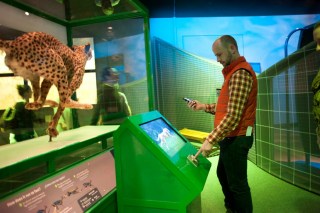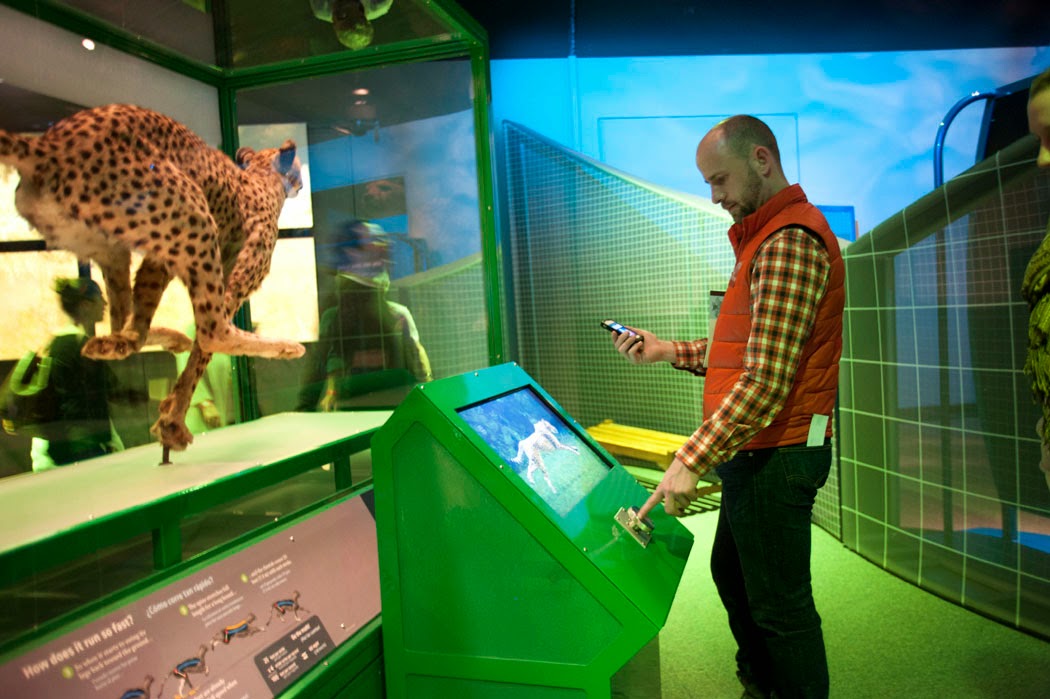Recently, the Field Museum commissioned research from Slover Linett Audience Research, exploring why people visit a natural history museum. Staff at the museum are using the results to figure out how different kinds of people do or don’t want to use digital media and interactives in the museum. They are also being generous in sharing the report with the field (applause). In today’s guest post, Matt Matcuk, Exhibitions Development Director, talks about the challenges to even beginning this study, and how their perseverance paid off.
In 2012 my colleagues and I at the Field Museum received funding from The Grainger Foundation for technological upgrades to our exhibits. To figure out what these upgrades might be, we set out to learn what visitors would want to get out of them. But to know that, we had to first know what our visitors want to get out of their experiences in general. We were looking for their fundamental motivations for coming to a natural history museum. And that is what the experts call a “Big Question.” So big, in fact, that when I proposed the study, people I talked with tended to fall into two groups.
Group A said:
“You don’t need to do that study. It’s simple. We already know why visitors come here.”
Group B said:
“You can’t do that study. It’s too complex. We’ll never really know why visitors come here.”
We forged ahead.
To address Group A’s concerns, we had to help visitors get past the obvious, familiar answers that come easily, but which tell us little:
It’s fun. We really like dinosaurs. It’s something we can do as a family. It’s educational.
Asking people on the spot to explain their motivations doesn’t usually yield good data. If the owners of an Italian restaurant stood at their customers’ tables and asked them why they came here to eat, they would get the same kind of answers:
It’s fun. We really like pasta. It’s something we can do as a family. It’s relaxing.
 |
| © The Field Museum, GN91954_596d, Photographer Karen Bean. |
Our study would also have to address Group B’s concerns. People do things for reasons that are complex, layered, and mysterious—to those of us studying their behavior, and sometimes to the visitors themselves. If our decisions result from the sum total of our experience, you could spend years studying the motivations of a single visitor. We had to arrive at a list of questions that was short enough to be practicable, but nuanced enough to be applicable to many kinds of visitors.
Group B’s objection (that we’ll never really know why visitors come here) applies to most research that involves human subjects. In advertising focus groups people will often claim to find a logical, reason-driven ad more compelling than one that takes an emotional approach. Sometimes it’s not that people can’t tell you the truth, it’s that they won’t: not because we’re liars, but because we’re tempted to either give answers that we think will make our questioners look good (“You’ve done a good job of convincing me here”), or give answers that make us look good (“I’m not an easy mark for manipulative ads”). In the museum context, some people who have spent twenty minutes in an exhibit with twenty thousand words of text, when asked how many of the labels they’ve read, calmly answer, “most of them.”
Why does asking people directly about their motivations provide the kinds of answers that led Groups A and B to discourage us from doing such a study? I think there are four reasons.
- Visitors’ answers represent a reflexive response; an automatic reaction to stimulus.
- Visitors are susceptible to the temptations described above: to either give answers they think we want to hear, or to give answers that make them look good.
- Questions that require analysis and synthesis can be hard to answer.
- Finally—because of these reasons—the answers that visitors give to direct questions about why they’ve come here tend to be low in risk and high in generality:
- “It’s fun,” means nothing more than, “this is something we like to do.” “Fun,” as an adjective, can be applied to everything from a round of mud-wrestling to an operetta.
- “We like dinosaurs/pasta” is just another way of saying, “We came here because natural history museums have dinosaurs/ Italian restaurants have pasta.”
- “It’s something we can do as a family,” is better—it hints at a direction for inquiry, at least—but is not yet a piece of actionable data.
- “It’s educational/relaxing,” is a summary of the outcomes that one typically associates with museums/restaurants, and uses language that’s too broad to be of much use.
Our study with Slover Linett attempted to avoid these pitfalls in order to better understand visitors’ attitudes towards technology in museums. A few of its findings:
- People see the museum not as a source of information, or as a partner with which to engage in dialogue, but rather as a facility or vehicle to use in order to achieve their own goals, using their own methods.
- By looking for patterns in those goals and methods, we can create psychographic profiles that describe a visitor’s attitudes towards digital technologies. Surprisingly, these attitudes show little correlation with demographic factors such as age or gender.
- The report emphatically reinforced that the majority of our visitors’ goals are social: visitors are spending time with us in order to get closer to each other.
- Visitors don’t come here to learn about a subject, or master a concept, but to be amazed: they expect us to furnish the platform on which they can have a blow-your-mind, Aha!, meaningful experience.
I hope that the Slover Linett study doesn’t just illuminate visitors’ attitudes towards various museum experiences, but casts additional light on a shift in the common psyche—an effect of the last several decades of information technology change. To put it bluntly, visitors see knowledge authorities such as museums as tools. And you don’t engage in dialogue with your tools—you use them. I think this points to a need for institutional humility that many museums have not yet fully recognized.
To get a clearer picture of the study’s findings, you can read the full report here. It’s not the last word on how a person’s reasons for visiting a natural history museum relate to their attitudes toward technology in exhibits. But it’s a pretty good start. Please let me know what you think.
11-12-14 addendum, here is a new executive summary, which includes links to the two original reports.









I'm not so interested in what you might do with technology in the museum – but I'm really interested in how you designed your survey to get meaningful responses. The problem you pose is a really interesting one, and it applies to all kinds of fields beyond the reasons why people go to museums. It's really the general question "why did you do this" – which can be answered at all different levels of generality or precision.
So I'd love to see your survey, and read more about how you ended up approaching that issue. I hope your report addresses those questions, doesn't just tell us your conclusions about introducing technology.